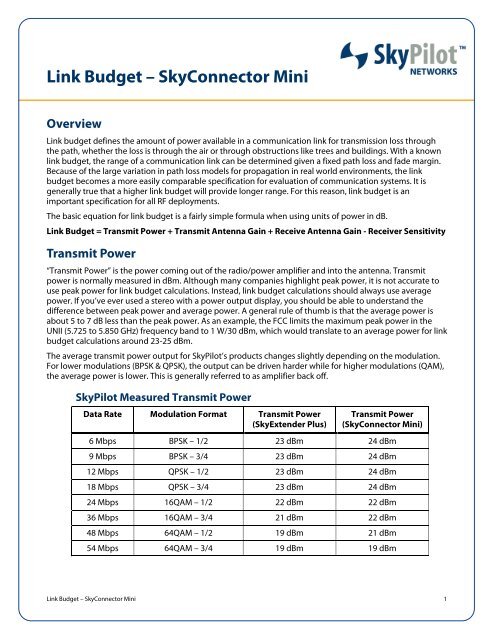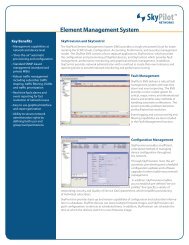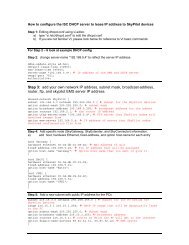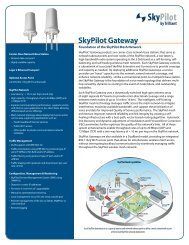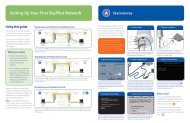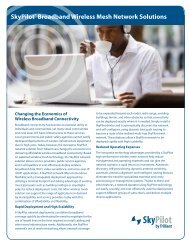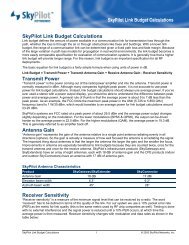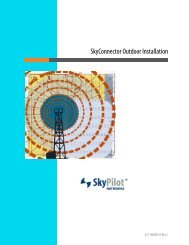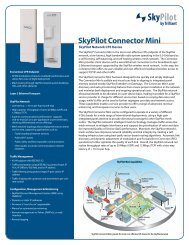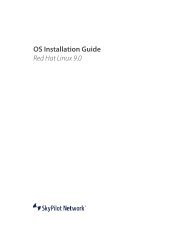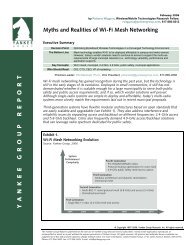Link Budget – SkyConnector Mini - SkyPilot
Link Budget – SkyConnector Mini - SkyPilot
Link Budget – SkyConnector Mini - SkyPilot
Create successful ePaper yourself
Turn your PDF publications into a flip-book with our unique Google optimized e-Paper software.
<strong>Link</strong> <strong>Budget</strong> – <strong>SkyConnector</strong> <strong>Mini</strong><br />
O ve r v i e w<br />
<strong>Link</strong> budget defines the amount of power available in a communication link for transmission loss through<br />
the path, whether the loss is through the air or through obstructions like trees and buildings. With a known<br />
link budget, the range of a communication link can be determined given a fixed path loss and fade margin.<br />
Because of the large variation in path loss models for propagation in real world environments, the link<br />
budget becomes a more easily comparable specification for evaluation of communication systems. It is<br />
generally true that a higher link budget will provide longer range. For this reason, link budget is an<br />
important specification for all RF deployments.<br />
The basic equation for link budget is a fairly simple formula when using units of power in dB.<br />
<strong>Link</strong> <strong>Budget</strong> = Transmit Power + Transmit Antenna Gain + Receive Antenna Gain - Receiver Sensitivity<br />
Transmit Power<br />
“Transmit Power” is the power coming out of the radio/power amplifier and into the antenna. Transmit<br />
power is normally measured in dBm. Although many companies highlight peak power, it is not accurate to<br />
use peak power for link budget calculations. Instead, link budget calculations should always use average<br />
power. If you’ve ever used a stereo with a power output display, you should be able to understand the<br />
difference between peak power and average power. A general rule of thumb is that the average power is<br />
about 5 to 7 dB less than the peak power. As an example, the FCC limits the maximum peak power in the<br />
UNII (5.725 to 5.850 GHz) frequency band to 1 W/30 dBm, which would translate to an average power for link<br />
budget calculations around 23-25 dBm.<br />
The average transmit power output for <strong>SkyPilot</strong>’s products changes slightly depending on the modulation.<br />
For lower modulations (BPSK & QPSK), the output can be driven harder while for higher modulations (QAM),<br />
the average power is lower. This is generally referred to as amplifier back off.<br />
<strong>SkyPilot</strong> Measured Transmit Power<br />
Data Rate Modulation Format Transmit Power<br />
(SkyExtender Plus)<br />
Transmit Power<br />
(<strong>SkyConnector</strong> <strong>Mini</strong>)<br />
6 Mbps BPSK – 1/2 23 dBm 24 dBm<br />
9 Mbps BPSK – 3/4 23 dBm 24 dBm<br />
12 Mbps QPSK – 1/2 23 dBm 24 dBm<br />
18 Mbps QPSK – 3/4 23 dBm 24 dBm<br />
24 Mbps 16QAM – 1/2 22 dBm 22 dBm<br />
36 Mbps 16QAM – 3/4 21 dBm 22 dBm<br />
48 Mbps 64QAM – 1/2 19 dBm 21 dBm<br />
54 Mbps 64QAM – 3/4 19 dBm 19 dBm<br />
<strong>Link</strong> <strong>Budget</strong> – <strong>SkyConnector</strong> <strong>Mini</strong> 1
<strong>Link</strong> <strong>Budget</strong> – <strong>SkyConnector</strong> <strong>Mini</strong><br />
Antenna Gain<br />
“Antenna Gain” represents the gain of the antenna relative to a single point antenna radiating evenly in all<br />
directions (i.e. a sphere). So the gain is actually a measure of how well focused the antenna is at radiating the<br />
signal. The important thing about antennas is that the larger the antenna the larger the gain and the smaller<br />
the focus. Improvements in antennas are especially beneficial to link budgets because they are counted<br />
twice, once for the transmit antenna and once for the receive antenna. <strong>SkyPilot</strong>’s infrastructure products<br />
(SkyGateways and SkyExtenders) have an array of eight antennas, each with 18 dBi of antenna gain, and<br />
<strong>SkyConnector</strong> <strong>Mini</strong> has an antenna with 14 dBi of antenna gain.<br />
<strong>SkyPilot</strong> Antenna Characteristics<br />
Product SkyExtender Plus <strong>SkyConnector</strong> <strong>Mini</strong><br />
Antenna Gain 18 dBi 14 dBi<br />
Elevation beam width 6° 18°<br />
Azimuth beam width 45° 55°<br />
Receiver Sensitivity<br />
“Receiver Sensitivity” is a measure of the minimum signal level that can be received by a radio. The word<br />
“received” has to be defined in terms of the quality of the link. At <strong>SkyPilot</strong>, we use a 10% packet error rate<br />
(PER) as the metric for link quality (this is the same metric used by RF chip companies as well). Testing is done<br />
with no external interference and the signal power is reduced until a 10% PER occurs, at which time the<br />
average power is then measured. Receiver sensitivity changes with modulation and data rates as shown in<br />
the table below (all numbers +/- 1.5 dB tolerance):<br />
<strong>SkyPilot</strong> Measured Receiver Sensitivity<br />
Data Rate Modulation Format Receiver Sensitivity<br />
(SkyExtender Plus)<br />
Receiver Sensitivity<br />
(<strong>SkyConnector</strong> <strong>Mini</strong>)<br />
6 Mbps BPSK – 1/2 -90 dBm -94 dBm<br />
9 Mbps BPSK – 3/4 -87 dBm -93 dBm<br />
12 Mbps QPSK – 1/2 -86 dBm -91 dBm<br />
18 Mbps QPSK – 3/4 -84 dBm -90 dBm<br />
24 Mbps 16QAM – 1/2 -80 dBm -86 dBm<br />
36 Mbps 16QAM – 3/4 -78 dBm -83 dBm<br />
48 Mbps 64QAM – 1/2 -70 dBm -77 dBm<br />
54 Mbps 64QAM – 3/4 -68 dBm -74 dBm<br />
<strong>Link</strong> <strong>Budget</strong> – <strong>SkyConnector</strong> <strong>Mini</strong> 2
<strong>Link</strong> <strong>Budget</strong> – <strong>SkyConnector</strong> <strong>Mini</strong><br />
Downlink <strong>Link</strong> <strong>Budget</strong> – from SkyExtender Plus to <strong>SkyConnector</strong> <strong>Mini</strong><br />
The summary for <strong>SkyPilot</strong>’s downlink link budget can therefore be calculated as follows:<br />
Modulation<br />
Rate<br />
Transmit<br />
Power<br />
Transmit<br />
Antenna Gain<br />
Receive<br />
Antenna Gain<br />
Receiver<br />
Sensitivity<br />
<strong>Link</strong> <strong>Budget</strong><br />
6 Mbps 23 dBm 18 dBi 14 dBi -94 dBm 149 dBm<br />
9 Mbps 23 dBm 18 dBi 14 dBi -93 dBm 148 dBm<br />
12 Mbps 23 dBm 18 dBi 14 dBi -91 dBm 146 dBm<br />
18 Mbps 23 dBm 18 dBi 14 dBi -90 dBm 145 dBm<br />
24 Mbps 22 dBm 18 dBi 14 dBi -86 dBm 140 dBm<br />
36 Mbps 21 dBm 18 dBi 14 dBi -83 dBm 136 dBm<br />
48 Mbps 19 dBm 18 dBi 14 dBi -77 dBm 128 dBm<br />
54 Mbps 19 dBm 18 dBi 14 dBi -74 dBm 125 dBm<br />
Uplink <strong>Link</strong> <strong>Budget</strong> – from <strong>SkyConnector</strong> <strong>Mini</strong> to SkyExtender Plus<br />
The summary for <strong>SkyPilot</strong>’s uplink link budget can therefore be calculated as follows:<br />
Modulation<br />
Rate<br />
Transmit<br />
Power<br />
Transmit<br />
Antenna Gain<br />
Receive<br />
Antenna Gain<br />
Receiver<br />
Sensitivity<br />
<strong>Link</strong> <strong>Budget</strong><br />
6 Mbps 24 dBm 14 dBi 18 dBi -90 dBm 146 dBm<br />
9 Mbps 24 dBm 14 dBi 18 dBi -87 dBm 143 dBm<br />
12 Mbps 24 dBm 14 dBi 18 dBi -86 dBm 142 dBm<br />
18 Mbps 24 dBm 14 dBi 18 dBi -84 dBm 140 dBm<br />
24 Mbps 22 dBm 14 dBi 18 dBi -80 dBm 134 dBm<br />
36 Mbps 22 dBm 14 dBi 18 dBi -78 dBm 132 dBm<br />
48 Mbps 22 dBm 14 dBi 18 dBi -70 dBm 124 dBm<br />
54 Mbps 19 dBm 14 dBi 18 dBi -68 dBm 119 dBm<br />
© 2008 <strong>SkyPilot</strong> Networks, Inc. All rights reserved. SkyGateway, SkyExtender,<br />
2055 Laurelwood Road<br />
<strong>SkyConnector</strong>, SkyAccess, SkyControl, SyncMesh, <strong>SkyPilot</strong>, <strong>SkyPilot</strong> Networks,<br />
the <strong>SkyPilot</strong> logo, and other designated trademarks, trade names, logos, and<br />
Santa Clara, CA 95054-2747<br />
brands are the property of <strong>SkyPilot</strong> Networks, Inc. or their respective owners.<br />
Product specifications are subject to change without notice. This material is<br />
408.764.8000<br />
provided for informational purposes only; <strong>SkyPilot</strong> assumes no liability related to<br />
US Toll Free 866 SKYPILOT<br />
its use and expressly disclaims any implied warranties of merchantability or<br />
<strong>Link</strong> <strong>Budget</strong> – <strong>SkyConnector</strong> <strong>Mini</strong> 3<br />
fitness for any particular purpose.<br />
sales@skypilot.com


